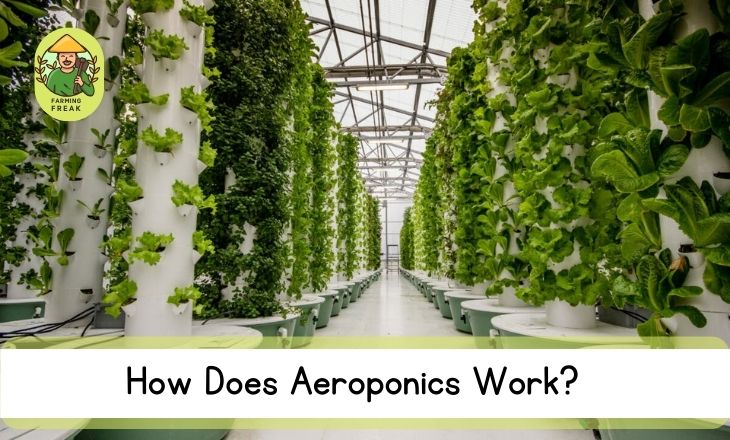Aeroponics may sound like something out of science fiction, but it’s very much a reality with real-world applications. By suspending plant roots in a nutrient-rich mist environment, aeroponic systems enable plants to thrive without the need for traditional soil-based cultivation.
The question appears in many minds How Does Aeroponics Work, the intricate mechanics behind aeroponics, you’ll gain insight into how this method encourages rapid growth and efficient use of resources while minimizing environmental impact.
What are Aeroponics systems?
Aeroponics systems are a modern and efficient method of growing plants that involve suspending the roots in the air and misting them with a nutrient-rich solution. This system allows for maximum oxygen exposure to the roots, promoting rapid growth and increased yields.
Aeroponics eliminates the need for soil, offering a clean and sustainable alternative for agriculture. These systems can be easily integrated into urban settings using vertical farming techniques, making it possible to grow fresh produce in small spaces such as rooftops or indoor facilities.
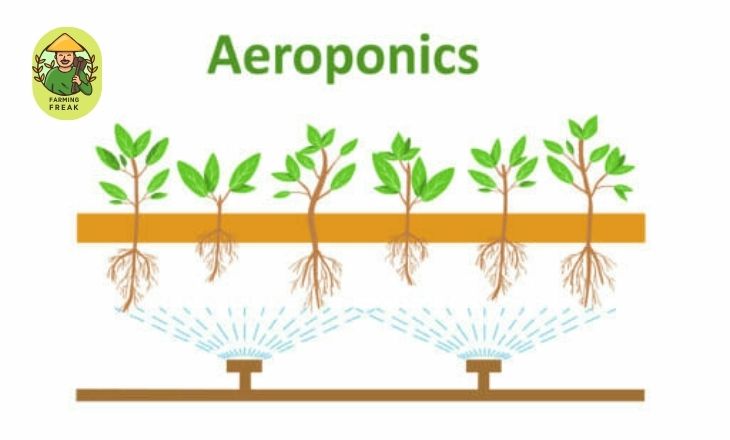
This not only promotes local food production but also reduces transportation costs and emissions associated with importing fruits and vegetables from distant locations. As technology continues to advance, the aeroponic system presents itself as an innovative solution to sustainable agriculture in an increasingly populated world.
How Does Aeroponics Work?
This method allows for higher oxygen levels, promoting faster and healthier plant growth. An aeroponic system typically includes a reservoir to hold the nutrient solution, a pump to deliver the solution to the roots, and misters or nozzles to create a fine mist for root absorption.
- The process begins with seedlings being placed into small baskets filled with an inert growing medium such as clay pellets. These baskets are then suspended in an enclosed chamber where the nutrient-rich mist is sprayed directly onto the roots at regular intervals.
- As the roots are constantly exposed to oxygen and nutrients in this misty environment, they can absorb water and nutrients more efficiently than traditional soil-based methods.
- The controlled environment of aeroponic also minimizes disease and pest issues while conserving water usage compared to other hydroponic systems.
- With its ability to produce larger yields in smaller spaces and its potential for vertical farming applications, aeroponic is revolutionizing modern agriculture by providing a sustainable and efficient way to grow fresh produce.
Exploring the Science and Unveiling the Secrets of Aeroponics Farming
Exploring the science behind aeroponic unveils its potential to transform modern agriculture. Have a look at the following facts.
- Beyond Soil
- Harnessing Air
- Misting Magic
- Growing Crops with Aeroponics at Home
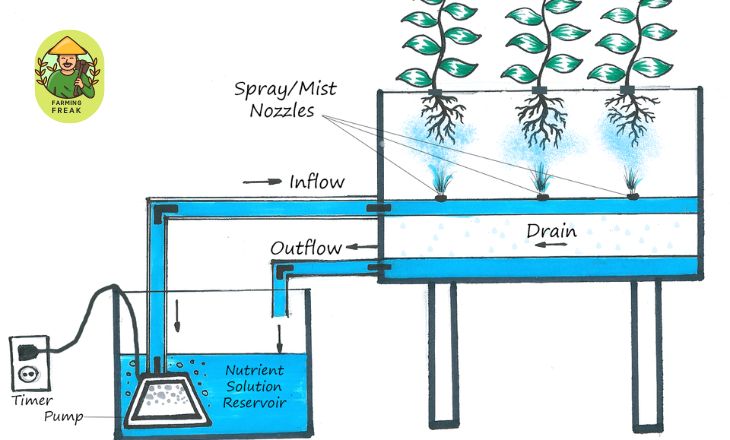
Beyond Soil:
Aeroponics farming is a revolutionary technique that goes beyond traditional soil-based agriculture.
By suspending plant roots in the air and nourishing them with a fine mist of water and nutrients, the aeroponic system eliminates the need for soil. This method not only conserves water but also allows for greater control over the plant’s environment, promoting faster growth and higher yields.
Harnessing Air:
Unlike traditional farming methods that rely on nutrient-rich soil, aeroponicc extracts essential elements directly from the air. The plants receive a continuous supply of oxygen, allowing their root systems to flourish without being confined by compacted soil.
This harnessing of air as a primary source of nutrition highlights the innovative nature of aeroponic farming, breaking free from conventional constraints and maximizing plant health.
Misting Magic:
The delicate yet powerful technique of misting serves as the magic touch in aeroponic farming. Instead of drowning plant roots in excessive amounts of water, this method delivers nutrients directly to where they’re needed most.
This precision not only conserves water but also reduces the risk of diseases caused by overwatering or stagnant moisture. Unveiling these secrets behind misting reveals its role as an essential component in nurturing thriving crops through aeroponic cultivation.
Growing Crops with Aeroponics at Home | Beginners Guide
- Aeroponic farming at home is the ability to control the growing environment with precision. By providing nutrients directly to the roots in a mist form, aeroponicc ensures efficient nutrient uptake and rapid growth.
- The space-saving nature of aeroponic systems makes it ideal for urban dwellers or those with limited gardening space. You can grow various crops with vertical towers or hanging gardens without needing expansive land.
- Beginners need to start small and experiment with different crops to understand what works best in their specific environment, investing in quality equipment and understanding the nutritional needs of each crop is crucial for success in aeroponic farming at home.
Aeroponics Unleashed: Boosting Crop Growth without Soil
This innovative method of crop production is revolutionizing the way we grow food by utilizing a soilless system.
Instead of relying on traditional soil, aeroponiccs suspend plant roots in the air and mist them with a nutrient-rich solution. This technique promotes faster growth, and higher yields, and requires significantly less water compared to conventional farming.
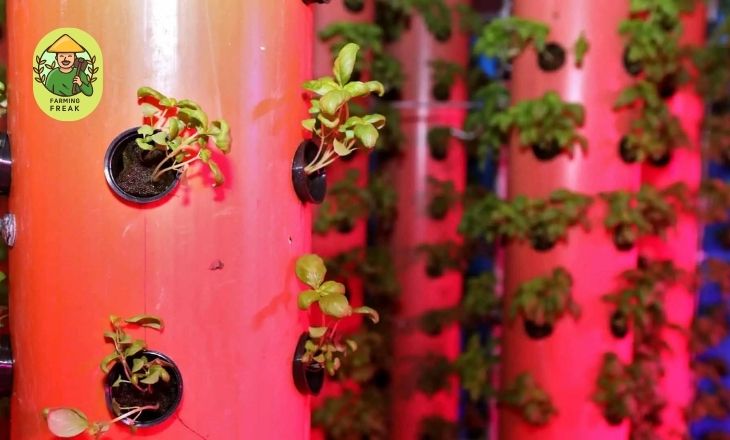
Maximum oxygenation:
Aeroponnics provides plants with optimal levels of oxygen, leading to improved nutrient absorption and overall healthier crops. This results in fewer instances of disease and pest infestations, contributing to more sustainable and environmentally friendly agriculture practices.
Precision control:
With aeroponics, farmers have precise control over the nutrients and environmental conditions that their crops are exposed to Just like in a permaculture garden.
This level of control allows for tailored adjustments based on specific crop needs, resulting in higher-quality produce with greater nutritional value.
Decoding the Aeroponics vs Hydroponics
Both methods offer innovative solutions for sustainable agriculture but have unique advantages depending on specific needs and resources available.
When it aeroponics vs hydroponics, it’s important to consider the different approaches each system takes in delivering nutrients to plants:
- Supplying Nutrients
- Water and Energy
- Versatility
- Comparing Roots
- Plant Growth and Health
- Environmental Impact
supplying nutrients:
Aeroponics uses a misting or fogging method to supply nutrients directly to the plant roots, allowing for efficient nutrient absorption and faster growth rates, while hydroponics relies on a water-based solution as the medium for delivering nutrients to the plants, providing a stable and controlled environment for growth.
water and energy:
One key distinction between these systems lies in their use of water and energy.
While hydroponic systems require a constant flow of water and electricity to maintain nutrient levels, aeroponic uses significantly less water due to its misting mechanism. This not only makes Aeroponnic more environmentally friendly but also reduces operating costs in the long run.
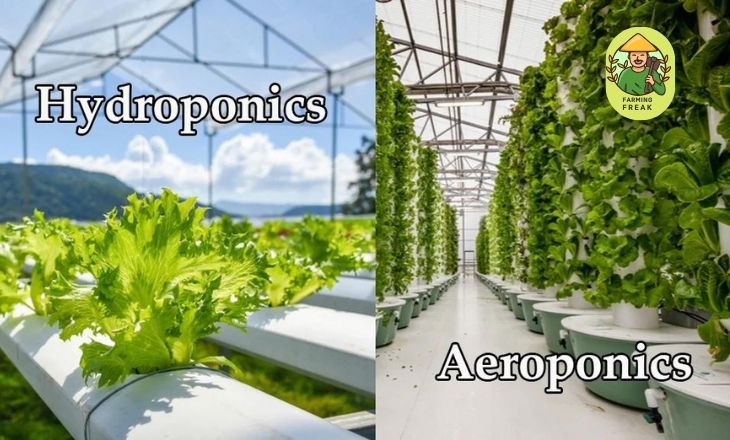
Versatility:
Hydroponics can be easier to set up and maintain for beginners, while aeroponics offers more precise control over nutrient delivery and oxygenation.
Deciding between these two methods ultimately depends on various factors such as space availability, budget constraints, and specific plant requirements.
Comparing Roots:
In Aeroponics, the plants are suspended in air and their roots are regularly misted with a nutrient-rich solution. This encourages the development of a fibrous root system, leading to efficient water and nutrient absorption.
Hydroponic systems use a static solution to immerse the plant roots, which can lead to root rot if not properly aerated.
Plant Growth and Health in Aeroponics vs Hydroponics:
Aeroponic systems have been shown to promote faster growth with healthier plants due to increased oxygen levels reaching the roots. This results in higher yields and better quality produce.
Hydroponics may require more vigilance as variations in the water’s oxygen content can impact plant health.
Environmental Impact:
Aeroponics has an edge over hydroponics due to its significantly lower water usage. The precise delivery of nutrients directly to the roots reduces wastage and promotes sustainability.
Aeroponic systems generally require less space compared to traditional soil farming or even hydroponics setups, making them more suitable for urban environments where space is limited.
Pros and Cons of Aeroponics Farming
Here are the following pros and cons which will help you in farming.
Pros of Aeroponics Farming:
- Efficient use of water as it delivers nutrients directly to the roots.
- Reduced risk of soil-borne diseases and pests due to the absence of soil.
- Faster plant growth and higher yields compared to traditional methods.
- Flexibility in location, making it suitable for urban or space-constrained areas.
- Lower resource requirements and environmental impact compared to traditional farming.
Cons of Aeroponics Farming
- High initial setup costs for specialized equipment and infrastructure.
- Requires a consistent supply of power and nutrient solutions for operation.
- Risk of system failure leading to potential loss of crops if not properly monitored.
Final Thoughts
Aeroponics is a revolutionary and efficient method of growing plants that offers numerous advantages over traditional soil-based agriculture. By delivering nutrients directly to the plant roots in a misty environment, aeroponnics maximizes nutrient uptake and promotes rapid growth.
This step-by-step guide on How Does Aeroponics Work provided above demonstrates how simple it can be to set up an aeroponic system and start growing healthy, vibrant plants at home or on a larger scale. With the potential to conserve water, reduce disease risk, and optimize space usage, aeroponiccs have the power to transform the future of farming.
FAQs
Is Aeroponic Better Than Hydroponic?
The choice between aeroponic and hydroponic systems comes down to your individual goals, resources, and level of expertise. Both methods have their advantages and disadvantages, so it’s important to carefully consider your specific needs before making a decision.
What Are The Advantages of Aeroponics Over Hydroponics?
Aeroponics offers faster plant growth and higher yields compared to hydroponics. The method allows for more efficient nutrient delivery directly to the roots, resulting in healthier and stronger plants, aeroponiccs uses less water and nutrients than hydroponics, making it a more sustainable option for growing crops.
What Can You Grow With Aeroponics?
With aeroponics, you can grow a wide variety of plants including herbs, leafy greens, strawberries, tomatoes, peppers, and even some root vegetables like potatoes and carrots. The nutrient-rich mist in aeroponic systems provides an ideal environment for plant growth and can be used to cultivate many different types of crops.
When to Add Nutrients to Aeroponnics Clones?
You should start adding nutrients to aeroponic clones once they have developed roots and are ready for transplanting. This is usually around 7-10 days after the clones have been placed in the aeroponic system. Make sure to use a balanced nutrient solution specifically designed for aeroponics to promote healthy growth and development.
- Can Ducks Eat Mushrooms? Unexplained Benefits and Risks - May 25, 2024
- Unveiled Capon Chicken: Capon Chicken Nutritional Benefits - May 25, 2024
- Can Goats Eat Cilantro? Exploring Benefits and Risks - May 24, 2024

